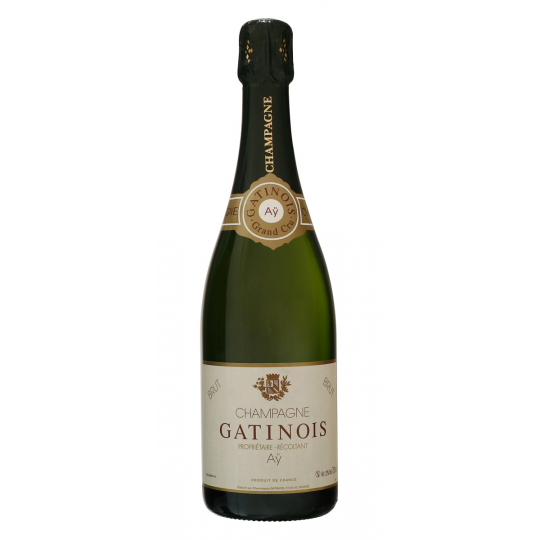De smaak
Een Champagne van topklasse. Uit het hart van de Grand Cru, staat voor een optimale combinatie van kracht en finesse.
Amberkleurig met verleidelijk veel verse aroma’s van fruit (aalbessen, appels, peren en grapefruit) en bloemen. Verfijnde rijke smaak met hints van brioche (zoetig Frans witbrood), hazelnoot en wit citrusfruit.
Wat een intensiteit en een lange prettige afdronk, uniek voor deze prijs!
De details
Type wijn: full bodied, Champagne
Druivensoort: 80% Pinot Noir, 20% Chardonnay
Teelt: conventioneel
Opvoeding: 24 maanden voor degorgeren, 1 jaar op fles
Alcoholgehalte: 12,00% vol.
Restsuiker: 7 g/l
Zuurgehalte:....
ph-waarde:....
Afsluiting: natuur kurk
Drinktemperatuur: 8 - 10 graden
Bewaarpotentieel: 2013 - 2020
Spijs-aanbeveling:
- Aperitief
- Vis: schaaldieren en zeefruit
- Vis: gepocheerd
- Salades & Antipasti
De oorsprong
Aÿ is de Pinot Noir hoofdstad van de Champagne en heeft een legendarische Champagne traditie. Alle 355 hectare wijngaarden zijn als Grand Cru ingedeeld. 90% van de aanplant is Pinot Noir en heeft dus de grote overhand in de Champagnes.
Gatinois ligt in het prachtige dorpje Aÿ, in de Marne vallei. Aÿ is het meest bekend als thuis van de beroemde merken als Bollinger, Gosset en Deutz, maar heeft ook een aantal uitstekende kleinere producenten. De beste onder hen is zonder twijfel Champagne Gatinois. De percelen liggen uitsluitend op de Grand Cru hellingen en geven veel karakter aan de Champagnes van het huis. Kracht gecombineerd met finesse zijn de sleutelwoorden.
Het Champagnehuis Gatinois produceert sedert 1696 wijn in Aÿ en is daarmee ook een van de oudste familiedomeinen. Jarenlang was het de traditie dat een groot deel van de oogst aan Bollinger werd verkocht. Onder leiding van Pierre Cheval-Gatinois ging het roer om en werden de allerbeste druiven alleen nog maar voor Gatinois Champagne gereserveerd.
Slimme Weetjes: De Grand Cru's
The classification of Champagne vineyards developed in the mid-20th century as a means of setting the price of grapes grown through the villages of the Champagne wine region. Unlike the classification of Bordeaux wine estates or Burgundy Grand cru vineyards, the classification of Champagne is broken down based on what village the vineyards are located in. A percentile system known as the Échelle des Crus ("ladder of growth") acts as a pro-rata system for determining grape prices. Vineyards located in villages with high rates will receive higher prices for their grapes than vineyards located in villages with a lower rating. While the Échelle des Crus system was originally conceived as a 1-100 point scale, in practice, the lowest rated villages are rated at 80%. Premier crus villages are rated between 90 and 99 percent while the highest rated villages, with 100% ratings are Grand crus. From Wikipedia, the free encyclopedia.
Slimme Weetjes: De Champagne regio
The Champagne province is located near the northern limits of the wine world along the 49th parallel. The high altitude and mean annual temperature of 10 °C (50 °F) creates a difficult environment for wine grapes to fully ripen. Ripening is aided by the presence of forests which helps to stabilize temperatures and maintain moisture in the soil. The cool temperatures serve to produce high levels of acidity in the resulting grape which is ideal for sparkling wine.
During the growing season, the mean July temperature is 18 °C (66 °F). The average annual rainfall is 630 mm (25 inches), with 45 mm (1.8 inches) falling during the harvest month of September. Throughout the year, growers must be mindful of the hazards of fungal disease and early spring frost.
Ancient oceans left behind chalk subsoil deposits when they receded 70 million years ago. Earthquakes that rocked the region over 10 million years ago pushed the marine sediments of belemnite fossils up to the surface to create the belemnite chalk terrain. The belemnite in the soil allows it to absorb heat from the sun and gradually release it during the night as well as providing good drainage. This soil contributes to the lightness and finesse that is characteristic of Champagne wine. The Aube area is an exception with predominately clay based soil. The chalk is also used in the construction of underground cellars that can keep the wines cool through the bottle maturation process. From Wikipedia, the free encyclopedia.


